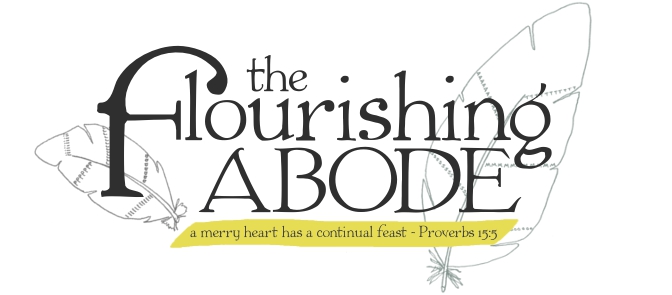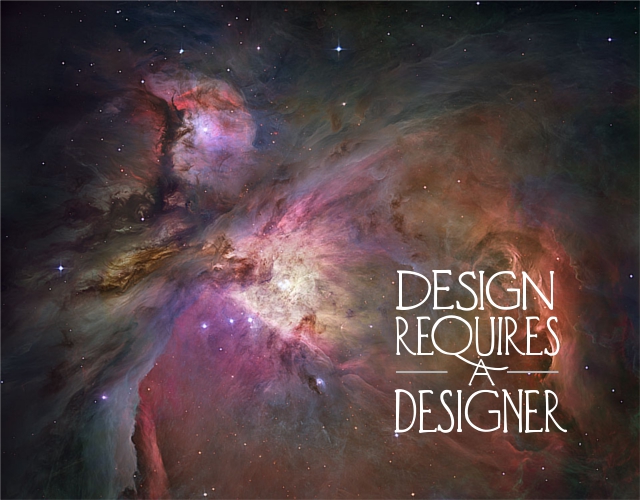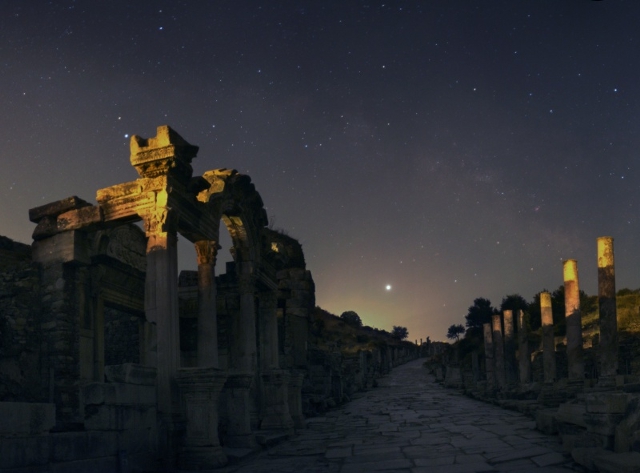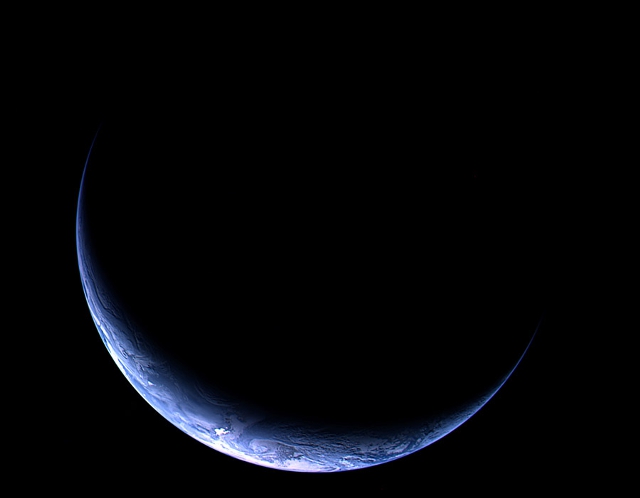Do any of you check out NASA’s Astronomy Picture of the Day? I remember discovering it several years ago – it’s really pretty neat. All the images/video I’ll be using in this post are from there, used with permission. You can click any image to go to the NASA page – you might just enjoy browsing around there, it is simply incredible! For instance, the image below – at first glance I thought it wasn’t a photo, I thought it must be an artist’s rendering of deep space. It is in fact a image taken by the Hubble Space Telescope of the Orion Nebula. As to thinking it was by an artist … well, that’s exactly what we’re going to be talking about in this part of the Truth & Evidences series.
Beautiful, isn’t it? It’s awesome. And I mean that in the true “awe inspiring” way, not just the “Hey, how does pizza for dinner sound?” kind of way.
I’d like to consider three “layers” to this image. One is the simple text on top. One is the way/technology by which this image was captured. And one is what the image is actually a picture of – the Orion Nebula. Which, if any, of these happened by chance?
Let’s take the first (and simplest) layer: the text. Did erosion and mutations of the image file happen to leave blank white pixels in the lower right hand corner, which just happened to shape into letters of the alphabet, which just happened to be arranged in the proper order to spell words, which just happened to be the words that are the title of this post? Is that too much of a stretch? Or did a graphic designer (me! *waves*) purposefully choose and layout those words to be there? Well, let’s stay open-minded about that one, and move on to the second “layer” – how the image was taken. Did a camera just accidentally get dropped into space and happen to travel exactly where it needed to be, capture the image, and random gravitational pulls and solar winds just happened to bring it back to earth, where it somehow managed to arrive safely and was then discovered by NASA scientists? Or, was carefully designed technology called the Hubble Space Telescope’s ACS (Advanced Camera for Surveys) and the European Southern Observatory’s La Silla 2.2 meter telescope used to build this image, which is a mosaic containing a billion pixels at full resolution and reveals about 3,000 stars? Which is the more reasonable explanation? Ok, now let’s consider the third layer – what it is actually an image of, the Orion Nebula. Was this made by some random explosion caused by energy that just accidentally happened to some matter, which came out of nothing in the first place? Or was a intelligent design involved in this third layer too? Which layer is the most amazing, the most complex? And yet, which layer is it that many would encourage us to see as just an accident?
Now, maybe the Orion Nebula seems a little … well, nebulous. A little hard to grasp exactly how amazing it is. So let’s look at some things closer to home, and see if they show evidence of a designer (like we would easily admit the other aspects of the image do, even down to something as simple as the text I added to the image).
The following is a video, also from NASA’s Astronomy Picture of the Day, showing what it looks like to fly over the earth at night. It’s breathtakingly beautiful – but the thing I want to point out specifically is all the lightning which you are looking down on in the video:
Did you know that the rate of lightning on earth must be in a specific balance? Too much, and there would be greater fire damage. Not enough, and there would be too little nitrogen fixing in the soil. We just “happen” to fall in that happy area in between.
This beautiful photo is also from NASA, and is a shot of Jupiter over the city of Ephesus.
Did you know that without Jupiter we would get pummeled with space debris? Jupiter’s greater gravitational pull and position in relation to the solar system causes it to pull in space material, offering us, in essence, a shield. How fortunate, eh?
But perhaps those still aren’t specific enough. Then consider our oxygen supply. Our air is about 20.95% oxygen. We need this amount to live. If it were 15%, humans would suffocate. If it were 25%, fires and explosions would be a huge problem. Also, if earth’s crust was too thick, there would be too much oxygen transferred to it, and we would suffocate – but if it was too thin volcanic activity would make the earth unlivable. Also, we have the proper balance of carbon dioxide. With too much, the greenhouse effect would become too strong and temperatures would become to high to survive. Too low, and plants wouldn’t be able to complete photosynthesis, and we would suffocate. Again, in all these things we “happen” to sit in that happy middle.
The list goes on and on. Astrophysicist Hugh Ross has compiled a list, and has worked on calculating the chance that a planet could just randomly and accidentally (that is, with no Designer) happen to have all these traits which allow life. His conclusion was that the chance was 1 out of 10^138. That number is 10 with 138 zeros after it. Numbers that large are too large to even fully comprehend. Just how big is that number? Well, to give you a sense of scale … the number of *atoms* in the observable *universe* is estimated by scientists to be around 10^80 (10 followed by 80 zeros). That is HUGE.
You wouldn’t assume that the text in the first image just happened by chance, and yet that is so relatively simple — how much more complex and perfectly poised is our world. Which of the two is more reasonable to believe just happened by random chance?
Just because we see and experience our world everyday doesn’t mean it’s “ordinary”, or that all the amazing aspects of it are to be taken for granted.
Leave your thoughts and comments below. :)





great post!
the question about “it’s all a random chance or there is a “designer” behind” is something i think often, moreover about if there is destiny, if we are a part of a story much big than we can think, or if all happen by chance… i really can’t think that we stay here only because we are lucky (as you say, our position on the universe, the presence of oxygen etc): i need to believe that there is someone who have think about all, also because someone has had to think about all mathematical and physical rules that groom the World! (but sure, their just too complicate for me to understand ahah still have to finish to understand what’s write in my high school’s phisic books xD)
and thanks for sharing images, they’re very impressives :)
Exactly, nature is all just so amazing, it couldn’t have just come to be by chance! Thanks for your comment, Fede. :)
I LOVE this post, April. Fantastic. I love looking at the APOD at the end of each day and just gasping at creation. Blows my mind.
Beautifully written, my dear!
Ah, a fellow APOD fan! Yeah, NASA’s images are simply amazing. Truth be told, I kind of forgot about the astronomy pictures for a while and recently came back on them again. So glad I did, they are truly awe inspiring. Thanks for your words of encouragement, Kristi! :)
You may want to follow this guy on FB. He was the photographer for one of the APODs a few of weeks ago. I love his photos showing up in my stream! http://www.facebook.com/lucperrotphoto
Oh fun, thanks for sharing :)
Great thoughts. To assume that the universe came to exist without a designer is so irrational, and yet so engrained in the minds of most Americans. I hope conversations like this will help people to see that they, themselves, have sufficient knowledge and reason to make their own judgement on the origins of our universe. Scientists and philosophers may be more knowledgeable than the average mind, but they are not immune to deception, arrogance, and logical fallacy – we cannot make the mistake of blindly following their every claim without considering the evidence for ourselves. I think we sell ourselves short sometimes, by assuming that we are not capable of making informed, rational decisions on these matters.
(P.S. What an awe-inspiring video. Oh to have a bird’s eye view of the aurora borealis!)
Excellent, excellent points. Thanks, Daniel. :)
This post reminded me of a quote by Russel M. Nelson when talking about the Big Bang he said, “Could an explosion in a printing shop produce a dictionary?” When we make the comparison it seems pretty clear that there is indeed a Designer!
Oh, great quote! And so true. Thanks for sharing :)
I ended up at your site via pinterest where I saw a Bible verse piece using a typeface I designed. I noticed that on the word “Lord” the R is running into the D as it seems that you don’t have the complementary typeface, Diehl Deco Alts. It has many more options for letters including superscript and subscript options, alternate “Q”s and so on. You can download the Alts typeface here: http://www.dafont.com/diehl-deco.font Enjoy!
Oh, wow, you are the one who designed that font! How cool – I love it! I use it often. :) I actually do have the Diehl Deco Alts … I just happen to prefer usually the original letters, even when they over lap – like the Q in the image of this post. But on that particular print you’re speaking of, I did use the alts font in Rejoice, where the R dips down lower, but the original R in Lord. It’s definitely handy to have both. :) Thanks so much!
Love this post, I love that video!!! I don’t understand how people can look at nature, or at a baby just after birth and doubt the existence of God, it baffles me. I also can’t imagine living this life, not knowing what my purpose is – or thinking I have no idea where I’m going when I die. It makes me so sad for people who live this way. They are missing out on so much joy our Heavenly Father has there just waiting for them. Not to mention the peace…
Thanks for your post, oh, and there is an app you can download to your phone where you can go and see what space junk/comets, etc. are passing through on any given night and track the exact time they will be over where you are, so you can see them go by – we just did this at a family reunion in AR – where you could see the sky/stars crystal clear – it was fascinating!!!! I’ll have to find out the name of it and I will let you know!!!
Thanks, Jara! I am, I suppose, behind the times because I don’t have an iPhone or anything like that. Maybe someday, but it’s just not in the budget yet, haha! But that app sounds really neat. :) Thanks for sharing! :)
Do you have a lot of star paraphanellia (sp?)? I think you have one of the coolest last names ever!!!
I found your blog because of your free “As for me and my house, we will serve the Lord” print – it now sits on my entry way table, thanks for that:)
Oh fun, it’s so neat to imagine things I’ve made in other people’s homes! :)
We have some star stuff, but not tons. We do have a print of Van Gogh’s “Starry Night” on our wall. And we like to go stargazing. In fact I did a whole post on stargazing, and made a free stargazing printable for anyone who wants it, you can find it here: https://www.theflourishingabode.com/2012/03/adventure-challenge-week-4-go-stargazing.html :)
I think there might be a website in addition to the app, I’ll let you know!
Oh, that would be neat!! We’re about to be borrowing a telescope from a friend, too! :)